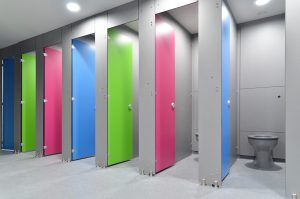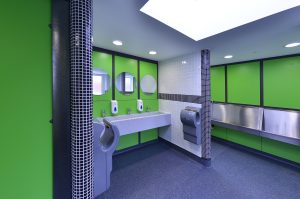Welcome to a world where clean and pristine washrooms are not just a dream, but a reality. In a constant battle against acts of vandalism that can tarnish the cleanliness of public restrooms, the need for anti-vandal washroom areas has never been more crucial.
Vandalism can take various forms, including graffiti, broken fixtures, and deliberate damage to hygiene facilities. Not only does this create an unhygienic and uninviting environment for restroom users, but it also results in costly repairs and maintenance for facility managers.
Thankfully, anti-vandal washroom areas provide a solution to this ongoing problem. By integrating durable and tamper-proof materials, such as reinforced doors, anti-tamper fixtures, and impact-resistant accessories, these washrooms can withstand even the most determined vandals.
In addition to the physical aspects, advanced security measures, such as surveillance systems and access control, can further deter vandals and ensure a safer environment for users.
Say goodbye to the frustration of dealing with vandalism and embrace the benefits of anti-vandal washroom areas. Discover how these innovative solutions can help preserve cleanliness and elevate the restroom experience for all.
The problem of vandalism in public washrooms
Public washrooms are often subject to acts of vandalism that can have a significant impact on cleanliness and user experience. Vandalism can range from minor graffiti to more severe damage, such as broken fixtures or deliberate destruction of hygiene facilities.
One of the main consequences of vandalism in washrooms is the negative impact on cleanliness. Graffiti and other forms of defacement can make washrooms appear dirty and uninviting, leading to a decrease in user satisfaction. Additionally, broken fixtures or damage to hygiene facilities can compromise their functionality, making it more difficult for users to maintain proper hygiene.
Moreover, vandalism in washrooms can result in costly repairs and maintenance for facility managers. Fixing broken fixtures or replacing damaged equipment can be a significant expense, especially in high-traffic areas where vandalism is more prevalent.
Understanding the importance of cleanliness in washroom areas
Cleanliness in washroom areas is of utmost importance for several reasons. Firstly, clean washrooms provide a hygienic environment for users, reducing the risk of diseases and infections. Proper sanitation practices are essential for maintaining good health, and clean washrooms play a crucial role in promoting hygiene.
Secondly, cleanliness in washrooms contributes to a positive user experience. A clean and well-maintained washroom creates a welcoming atmosphere, ensuring that users feel comfortable and at ease. This is particularly important in public spaces, where washrooms are a reflection of the overall cleanliness standards of the facility.
Furthermore, cleanliness in washrooms can have an impact on the reputation of a facility. A poorly maintained washroom can leave a negative impression on visitors, potentially affecting their perception of the entire establishment. On the other hand, a clean washroom demonstrates a commitment to providing a pleasant experience for users, enhancing the overall reputation of the facility.
How anti-vandal washroom areas can prevent vandalism
Anti-vandal washroom areas are specifically designed to prevent and minimize acts of vandalism. These washrooms incorporate various features and materials that are resistant to vandalism and damage, ensuring a clean and secure environment for users.
One key aspect of anti-vandal washroom areas is the use of durable and tamper-proof materials. Reinforced doors made of sturdy materials, such as stainless steel or high-density polyethylene, are difficult to break or damage. Similarly, anti-tamper fixtures, such as vandal-resistant faucets and soap dispensers, are designed to withstand attempts at tampering or destruction.
Moreover, anti-vandal washroom areas often include impact-resistant accessories. These accessories, such as mirrors and hand dryers, are made from materials that can withstand forceful impact without shattering or breaking. By incorporating these impact-resistant elements, the risk of damage or destruction is greatly reduced.
In addition to physical features, advanced security measures can further deter vandals and ensure a safer environment. Surveillance systems, including CCTV cameras, can help monitor washroom areas and provide evidence in case of vandalism. Access control systems, such as key card or biometric entry systems, can restrict access to authorized personnel, minimizing the risk of vandalism by unauthorized individuals.
Key features of anti-vandal washroom areas
Anti-vandal washroom areas boast several key features that make them highly resistant to acts of vandalism. These features are carefully designed to deter vandals and ensure the longevity and cleanliness of the washroom.
One important feature is the use of reinforced doors. These doors are made from robust materials that are resistant to breaking or damage, making it difficult for vandals to gain unauthorized access or cause destruction.
Additionally, anti-vandal washroom areas incorporate anti-tamper fixtures and fittings. These fixtures are designed to be resistant to tampering or destruction, ensuring that users can still access and use the facilities without interruption.
Another key feature is the use of impact-resistant accessories. Mirrors, hand dryers, and other accessories are made from durable materials that can withstand forceful impact, reducing the risk of damage or breakage.
Furthermore, advanced security measures such as surveillance systems and access control are often integrated into anti-vandal washroom areas. These measures provide an additional layer of protection and deterrence against vandalism, ensuring a safer environment for users.
Case studies showcasing the effectiveness of anti-vandal washroom areas
Numerous case studies have demonstrated the effectiveness of anti-vandal washroom areas in preventing vandalism and preserving cleanliness.
In a busy shopping mall, the implementation of anti-vandal washroom areas resulted in a significant reduction in acts of vandalism. The use of reinforced doors, anti-tamper fixtures, and impact-resistant accessories deterred vandals and prevented damage to the facilities. As a result, the washrooms remained clean and inviting, enhancing the overall shopping experience for visitors.
Similarly, in a public park, the introduction of anti-vandal washroom areas led to a noticeable decrease in graffiti and damage to hygiene facilities. The durable materials and tamper-proof fixtures minimized the opportunities for vandalism, creating a more pleasant environment for park-goers. The reduced need for repairs and maintenance also resulted in cost savings for the park management.
These case studies highlight the effectiveness of anti-vandal washroom areas in preserving cleanliness and preventing acts of vandalism. By investing in these innovative solutions, facility managers can create a safer and more appealing restroom experience for all users.
Implementing anti-vandal measures in your washroom facility
If you are considering implementing anti-vandal measures in your washroom facility, there are several steps you can take to ensure successful implementation.
Firstly, conduct a thorough assessment of your washroom facility to identify areas that are susceptible to vandalism. This will help determine the specific anti-vandal features and materials that would be most effective in preventing damage.
Next, consult with experts in the field of anti-vandal washroom areas to understand the available options and their suitability for your facility. These experts can provide valuable insights and recommendations based on their experience and expertise.
Once you have selected the appropriate anti-vandal features and materials, engage professional contractors or suppliers to install and integrate them into your washroom facility. Proper installation is essential to ensure the effectiveness and longevity of the anti-vandal measures.
Finally, communicate the implementation of anti-vandal measures to restroom users through signage or other means. This will create awareness and deter potential vandals, contributing to the success of the anti-vandal washroom areas.
By taking these steps, you can effectively implement anti-vandal measures in your washroom facility and protect against acts of vandalism, preserving cleanliness and user satisfaction.
Maintenance and upkeep of anti-vandal washroom areas
To ensure the continued effectiveness of anti-vandal washroom areas, regular maintenance and upkeep are essential. Here are some key considerations for maintaining these specialized washrooms.
Firstly, establish a maintenance schedule that includes regular inspections and cleaning. This will help identify any signs of damage or tampering and allow for prompt repairs or replacements.
Secondly, train cleaning staff on proper cleaning techniques for anti-vandal washroom areas. It is important to use appropriate cleaning agents and tools that will not cause damage to the durable materials or tamper-proof fixtures.
Additionally, consider implementing a preventive maintenance program that includes routine checks and servicing of surveillance systems and access control systems. This will help ensure that these security measures are functioning properly and providing the necessary protection against vandalism.
Lastly, encourage restroom users to report any signs of vandalism or damage they may encounter. Establishing a feedback mechanism will allow for timely intervention and maintenance, preventing further deterioration and ensuring the ongoing cleanliness of the washroom.
By prioritizing maintenance and upkeep, you can maximize the longevity and effectiveness of anti-vandal washroom areas, preserving cleanliness and user satisfaction throughout their lifespan.
The cost-effectiveness of anti-vandal washroom areas
While the initial investment in anti-vandal washroom areas may be higher compared to conventional washrooms, they offer long-term cost savings through reduced repairs and maintenance.
By incorporating durable and tamper-proof materials, anti-vandal washroom areas are less prone to damage and vandalism. This means fewer repairs and replacements are required, resulting in significant cost savings over time.
Moreover, the decreased need for repairs and maintenance translates to less downtime for the washroom facility. Conventional washrooms often require frequent closures for repairs, inconveniencing users and potentially impacting customer satisfaction. With anti-vandal washroom areas, the need for closures is minimized, ensuring a more uninterrupted restroom experience for users.
Additionally, the reputation and image of a facility can benefit from the implementation of anti-vandal washroom areas. A clean and well-maintained washroom facility reflects positively on the overall establishment, potentially attracting more customers and enhancing customer satisfaction.
In the long run, the cost-effectiveness of anti-vandal washroom areas becomes evident through reduced repair expenses, minimized downtime, and improved customer perception. Investing in these innovative solutions is not only a step towards preserving cleanliness but also a smart financial decision.
Conclusion: The impact of anti-vandal washroom areas on cleanliness and customer satisfaction
In conclusion, anti-vandal washroom areas offer a comprehensive solution to the ongoing problem of vandalism in public washrooms. By incorporating durable and tamper-proof materials, along with advanced security measures, these washrooms can effectively prevent acts of vandalism and preserve cleanliness.
Cleanliness in washroom areas is crucial for maintaining good hygiene, promoting positive user experiences, and enhancing the reputation of a facility. Vandalism in washrooms can compromise these objectives, leading to unhygienic environments, costly repairs, and a negative perception among users.
However, by implementing anti-vandal washroom areas, facility managers can mitigate the risks associated with vandalism. These specialized washrooms incorporate features such as reinforced doors, anti-tamper fixtures, and impact-resistant accessories, ensuring a durable and secure environment for users.
Case studies have demonstrated the effectiveness of anti-vandal washroom areas in reducing vandalism and preserving cleanliness. By investing in these innovative solutions, facility managers can create a safer and more appealing restroom experience for all users.
Regular maintenance and upkeep are essential for ensuring the continued effectiveness of anti-vandal washroom areas. By establishing a maintenance schedule, training cleaning staff, and implementing preventive maintenance programs, facility managers can maximize the longevity and functionality of these specialized washrooms.
While the initial investment in anti-vandal washroom areas may be higher, they offer long-term cost savings through reduced repairs, minimized downtime, and improved customer perception. Investing in these innovative solutions is a step towards preserving cleanliness and enhancing customer satisfaction.
Say goodbye to the frustration of dealing with vandalism and embrace the benefits of anti-vandal washroom areas. With their ability to prevent acts of vandalism and preserve cleanliness, these innovative solutions are the key to a cleaner and more inviting restroom experience for all.





